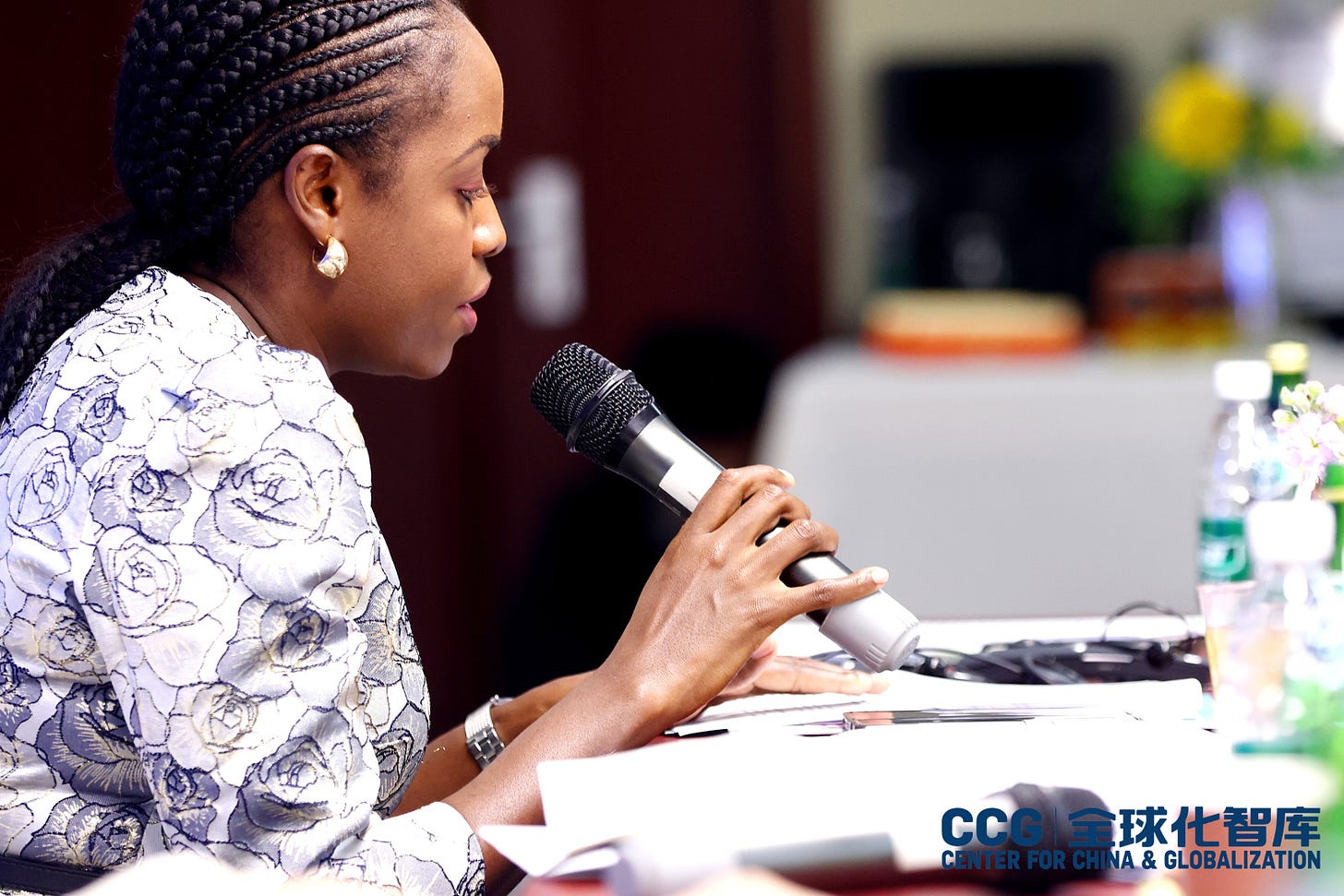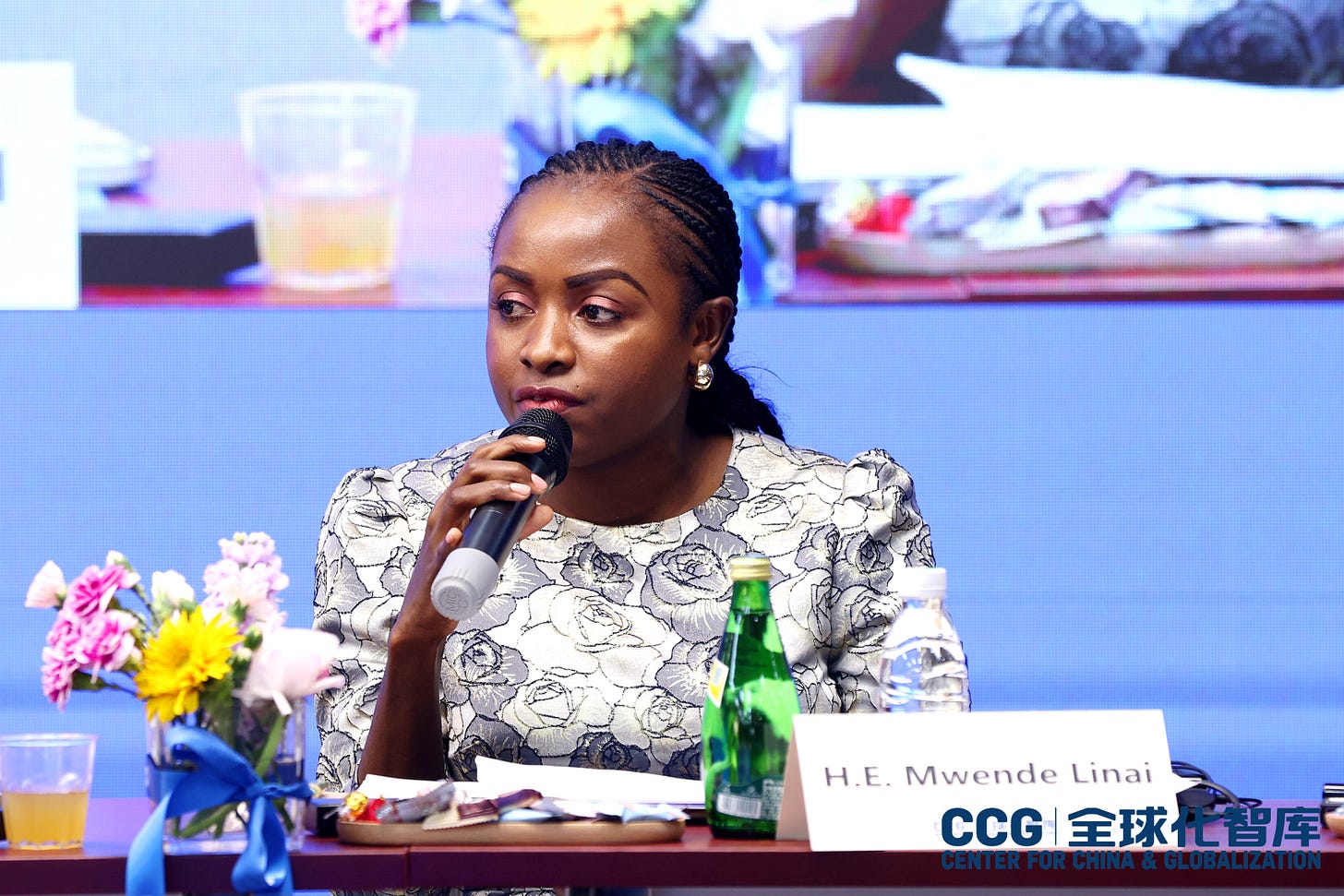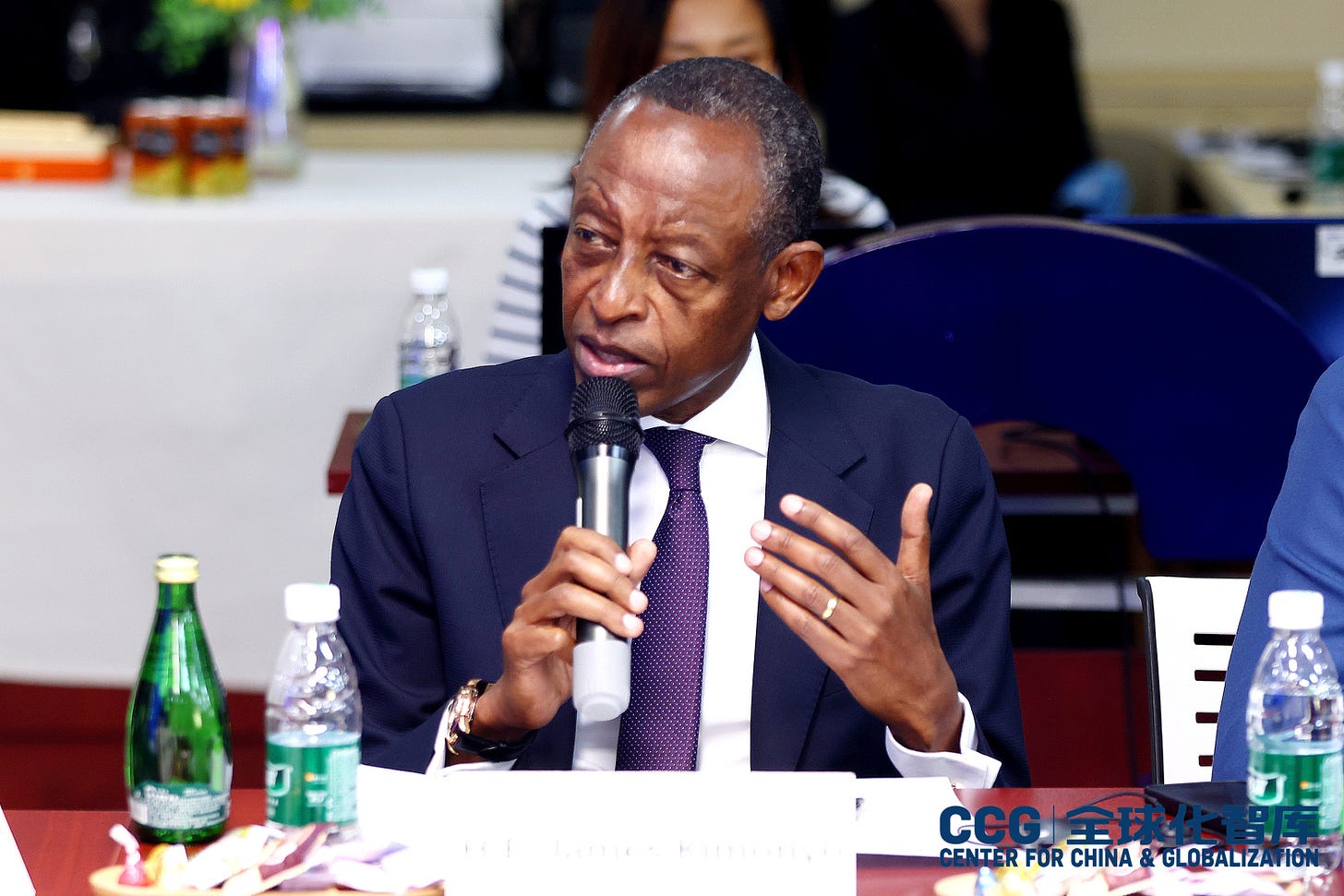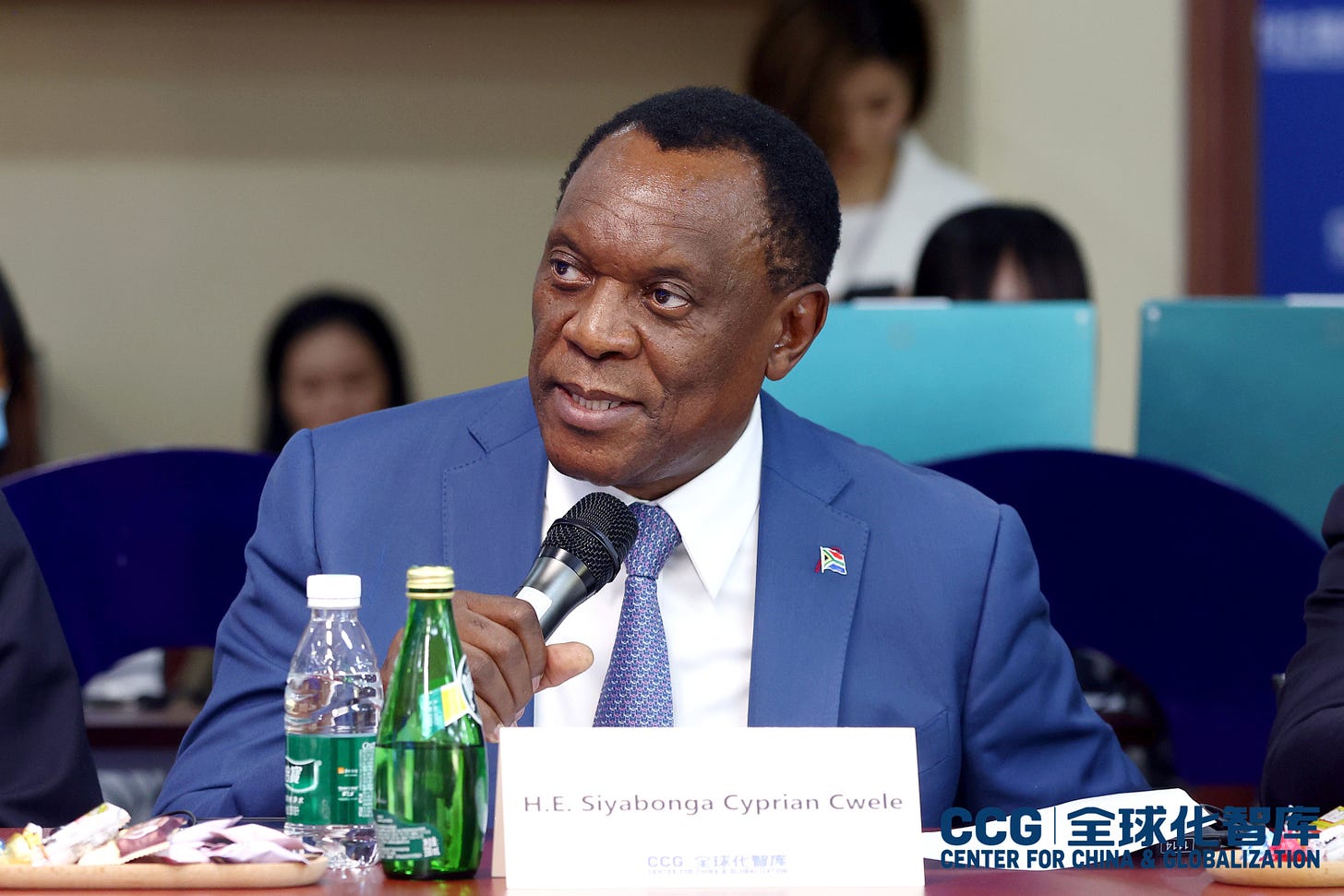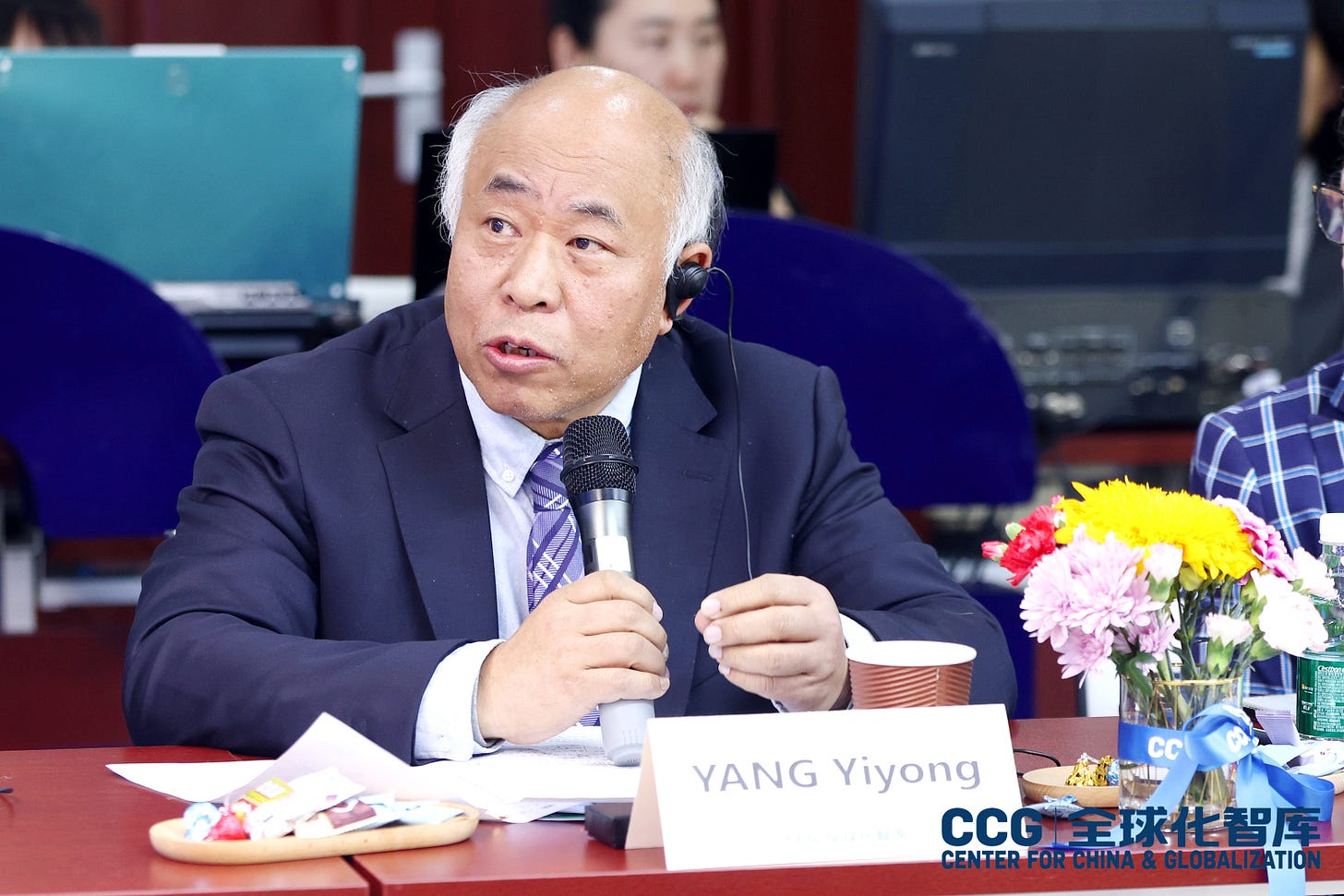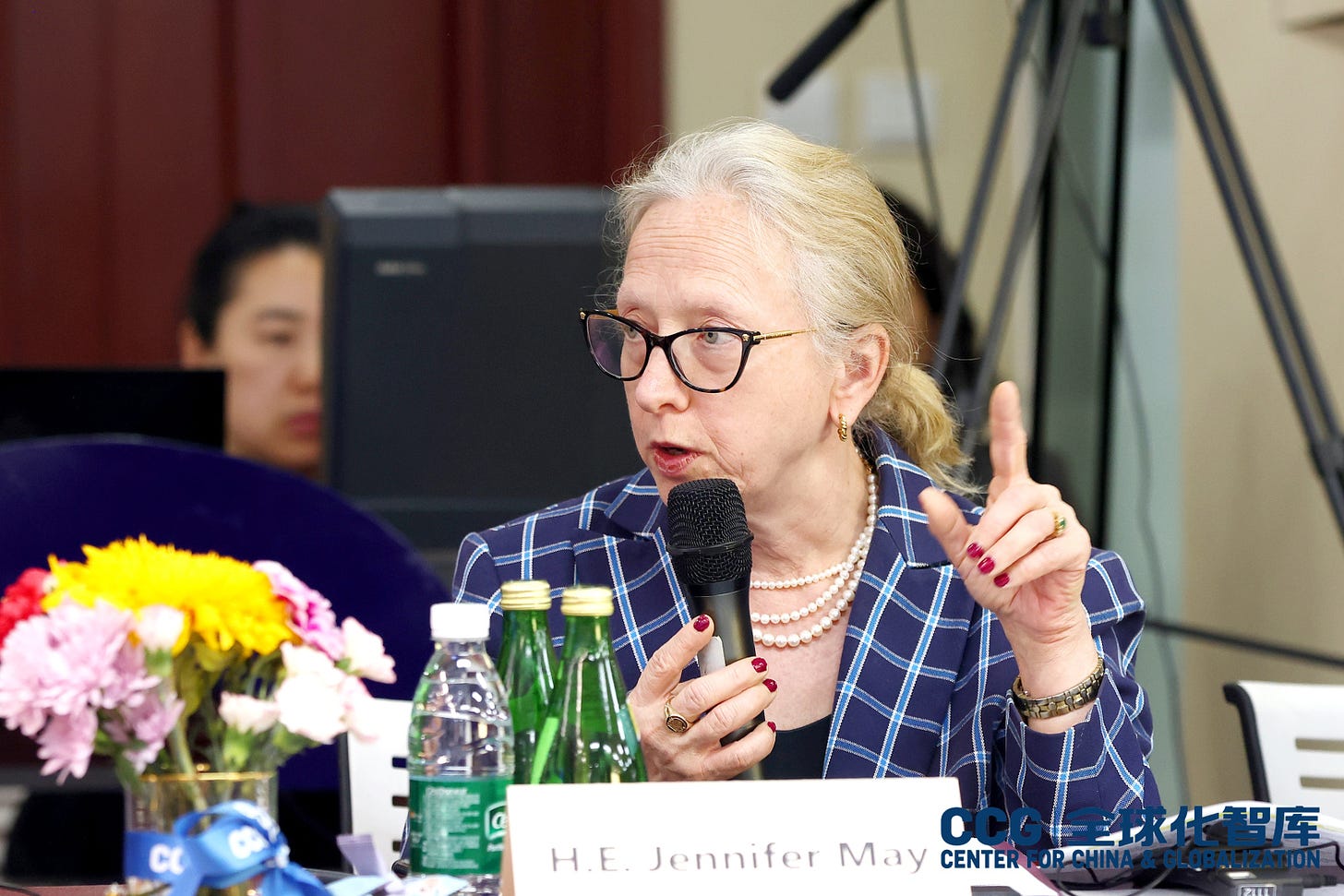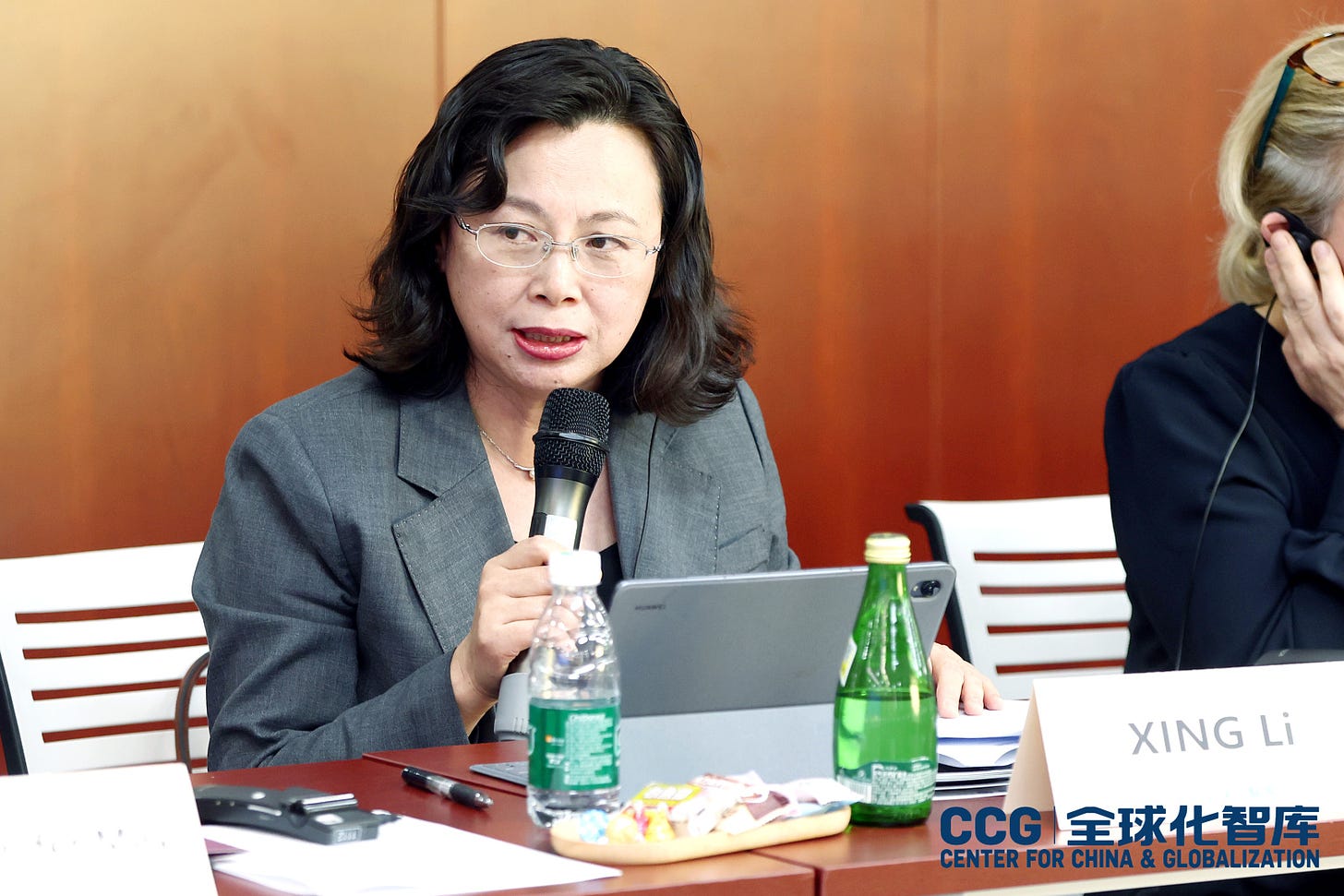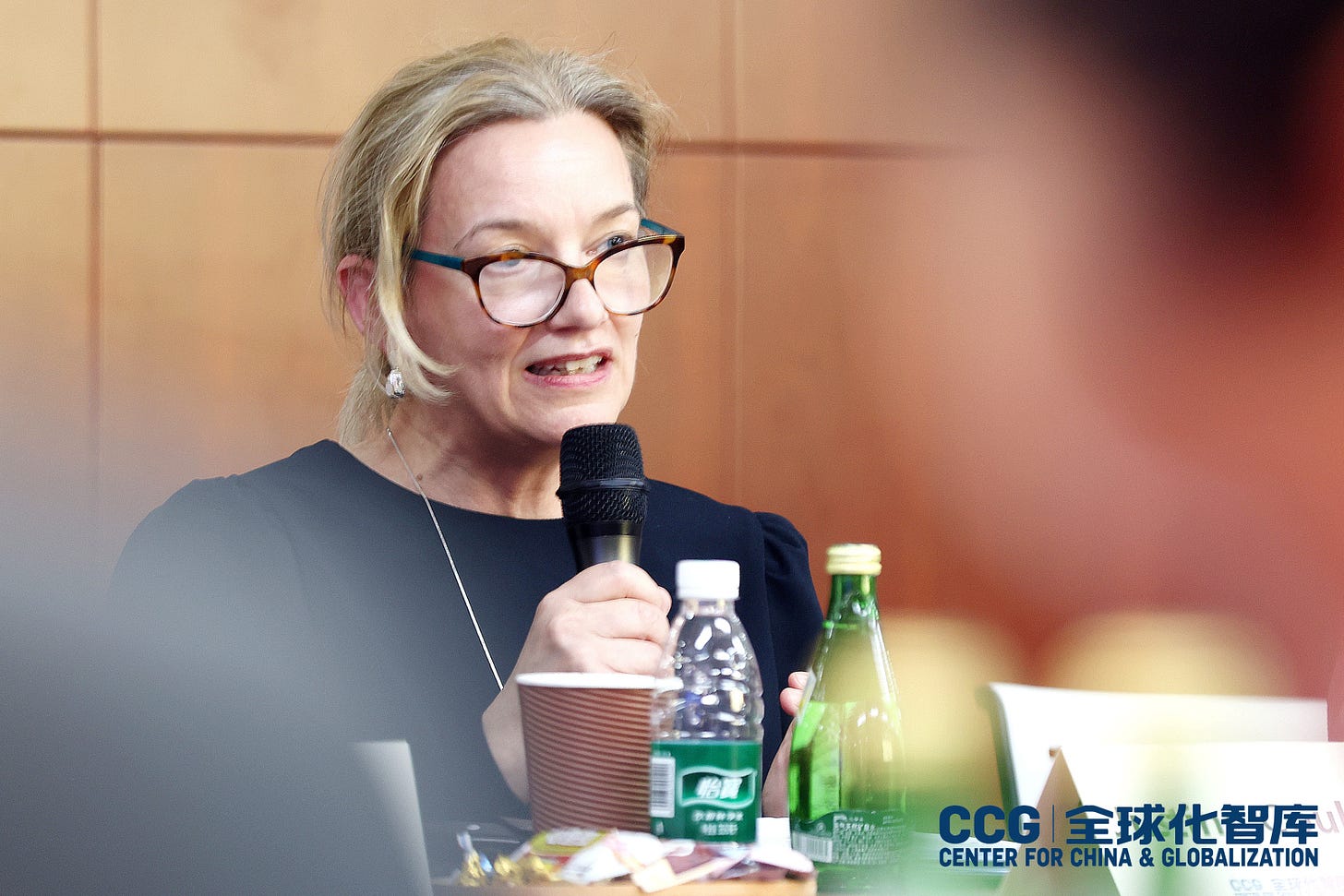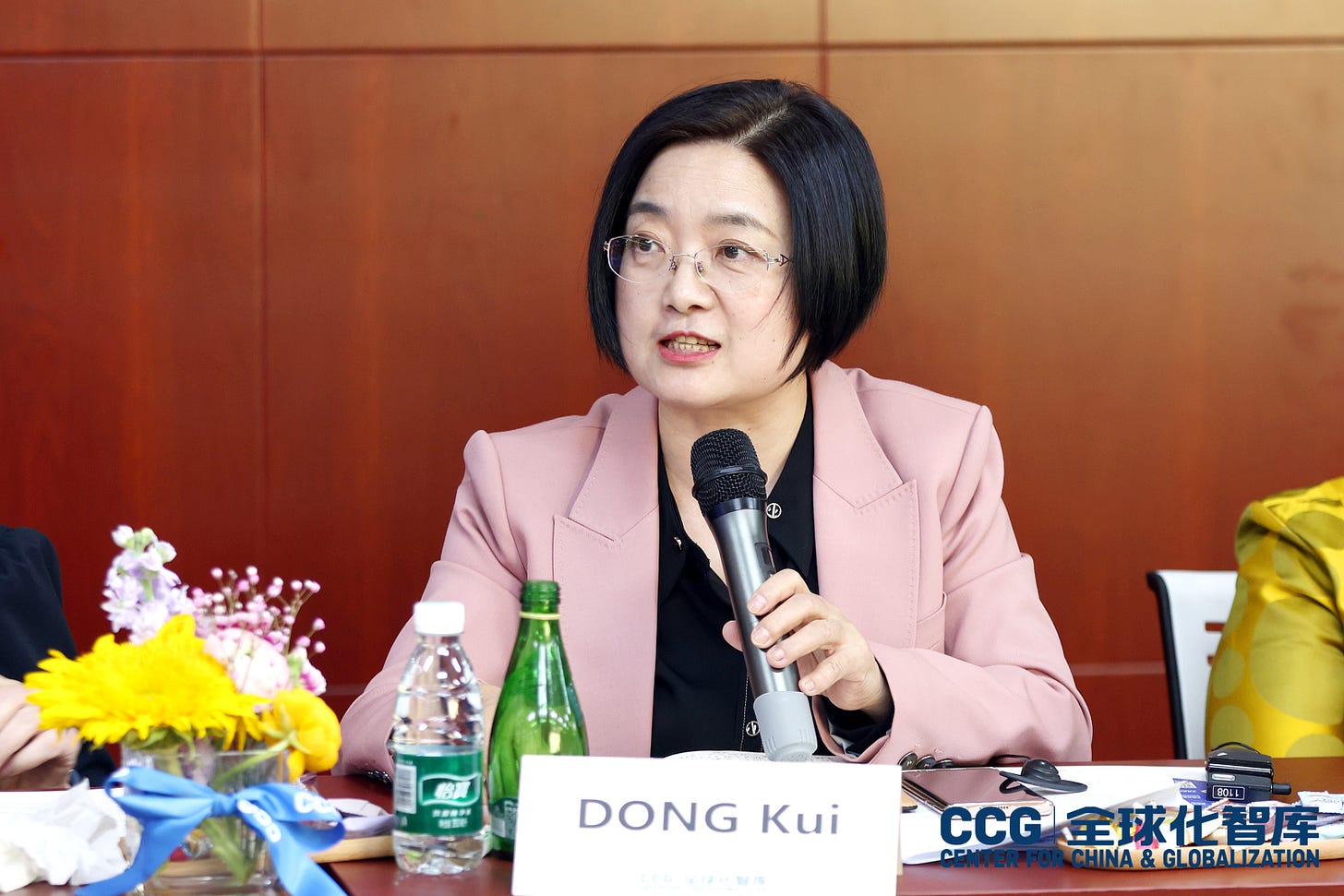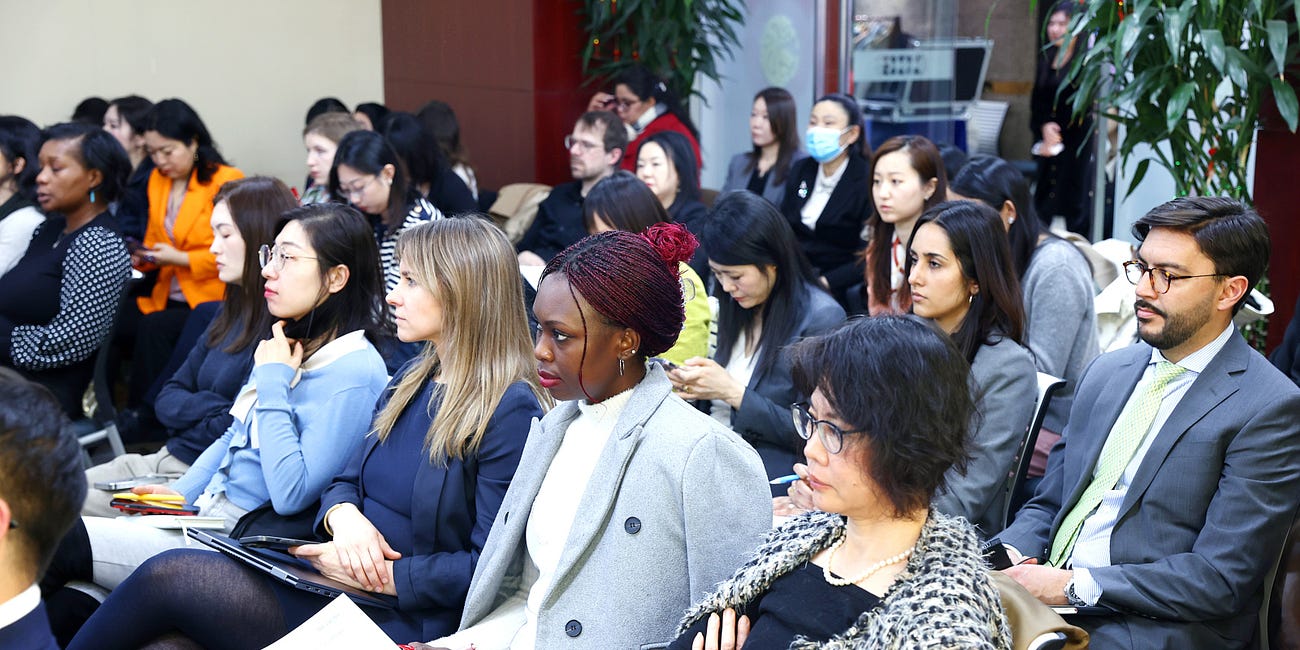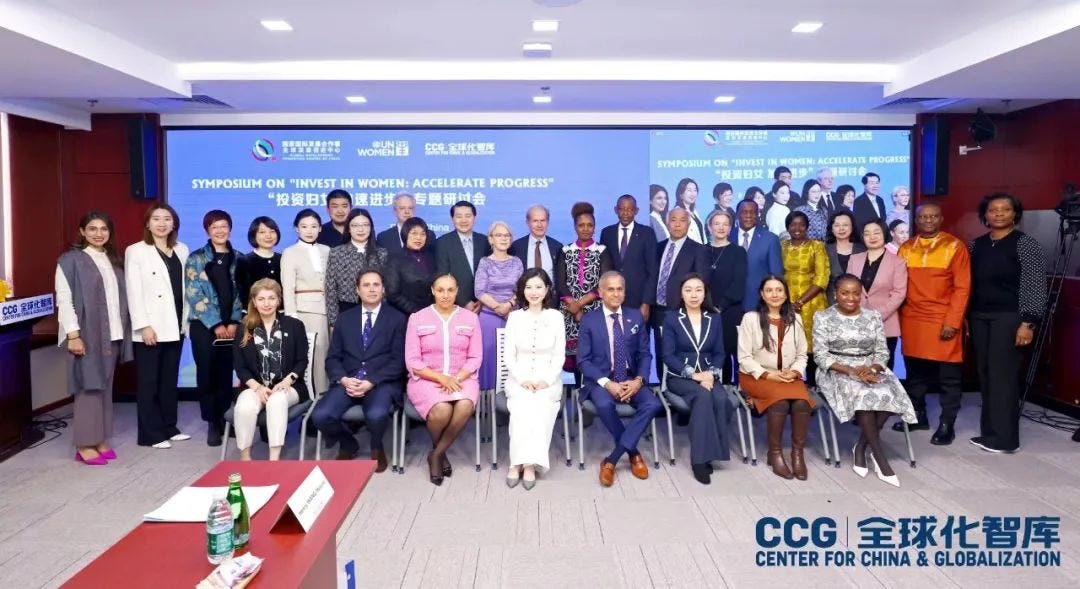Best practices for women empowerment from Rwanda, South Africa, China, Canada, & the UN
Theme 2 of 3 from CCG's joint event with China International Development Cooperation Agency and the UN Women China Office in celebration of women's rights and achievements.
Hi, this is Yuxuan Jia in Beijing. On March 8, 2024, celebrating International Women's Day with the goal of the achievement of SDG 5: Achieve gender equality and empower all women and girls by 2030, a symposium titled "Investing in Women: Accelerating Progress" was organized at the headquarters of Center for China & Globalization (CCG) in Beijing. This event was a joint effort by the CCG, the Global Development Promotion Center (GDPC) of the China International Development Cooperation Agency (CIDCA), and the UN Women China Office.
The symposium successfully convened nearly a hundred representatives from various sectors both within China and internationally, including government bodies, diplomatic entities in China, UN organizations, financial institutions, the private sector, academia, and civil society organizations.
The full event was broadcast on domestic Chinese media platforms. It is also available on YouTube.
Having published the opening remarks and the first panel from the event, the CCG Update will feature the second panel, moderated by Mwende Linai, Deputy Head of Kenya to China, with contributions from:
James Kimonyo, Ambassador of Rwanda to China
Siyabonga Cyprian Cwele, Ambassador of South Africa to China
Yang Yiyong, Director of the Institute of Market and Price Research, National Development and Reform Commission (NDRC)
Jennifer May, Ambassador of Canada to China
Xing Li, Vice President, Chinese Academy of Fiscal Sciences, Ministry of Finance of China
Justine Coulson, UNFPA Representative to China and Country Director for UNFPA in Mongolia
Dong Kui, Secretary-General, China Women's Development Fund
Moderator - Mwende Linai, Deputy Head of Kenya to China
Good afternoon,
Distinguished guests,
Director-General Ms. Tang, Representative of CIDCA,
Mabel, Director and SG from CCG,
Thank you so much to the UN Women in China, Madame Smriti,
for inviting me to moderate this session. I'd like to say I'm a young woman in STEM and I also want to wish "Hello women here" and "Happy International Women's Day."
So, to my lovely panelists on my left – we're very short of time – our session today is quite engaging. We've seen on social media the issue of financing for gender equality, and I'm sure you'll bear with us if we try and move away from the time. And it is my distinguished honor to also acknowledge the entire UNICEF led by my big sister there Amakobe (Sande) who's given me the opportunity to moderate.
Today, I would like to set the tone for this next engagement because we're going to wear our public policy lens and we're going to try and look at what instruments – whether from a legal perspective, whether from our regulatory frameworks – what is it that our governments are doing to lead by policy design, to lead in terms of incentivizing the work on financing for general equality. And with that being said, it is my honor to start us off with His Excellency and Ambassador of Rwanda, James Kimonyo.
We do know that our countries have advanced their course in developing and designing national strategies on gender. And we do appreciate countries like Rwanda that are leading in this National Gender Policy. If you may allow me, Your Excellency, I'd like to dig deeper on how Rwanda has been able to prioritize gender equality and women's empowerment into actual tangible policy incentives and resource allocation. Today, we're grappling with financial systems that are not inclusive. And we do want to hear what Rwanda has been able to say.
If you may add, the Global Gender Gap Report 2023 ranks Rwanda among the top 10 countries for narrowing the gender gap. In this regard, the UN Women has worked with Rwanda to actively promote women's equal benefits from governance systems to enhance access to social protection. Over to you to speak to us more on your government's incentives.
James Kimonyo, Ambassador of Rwanda to China
Thank you very much, my sister, Mwende. Thank you, Smriti and Dr. Mabel for inviting me. And I want to start by joining others to congratulate women and wish you a happy International Women's Day.
The previous panel touched on very important issues, and I want to begin my submission on what Beate said – the issue of Gender Equality and Women Empowerment is a fundamental human rights issue. Secondly, it is a very crucial ingredient of socioeconomic development. Once you have that perspective, then the approach to all these issues we're discussing becomes easier.
But I want to state here that the elephant in the room is political tuning with these fundamental challenges that we face when it comes to ensuring equality. That's where the problem lies. The moment you don't realize that in some of our societies, women are the majority in our population, that they have the capacity like men and you don't give them access to positions that make, define, and determine their destiny, then you're missing the point.
Now, because we're running short of time, let me say that the starting point, the cornerstone of what Rwanda has achieved in the past years is based on this understanding: for us, to be able to execute programs that are meant to ensure equality across our society, we had to start with the Constitution. So Rwanda's Constitution of 2003, as amended in 2015, provides for fighting any forms of discrimination, including ensuring gender equality, because, as I said, this is a fundamental human rights issue.
Therefore, for you to be able to achieve that, you have the political will, but that's not the end of it all. What is the policy and legal framework that is in place? What are the instruments that you're putting in place as a government to make sure that this vision is going to be achieved? Now there's a whole list of policies and a whole list of rules that have been enacted in Rwanda to ensure that women have access to everything that men have access to. If you look at the National Gender Policy, for instance – it has been revised several times – it clearly provides a framework through which all stakeholders act to make sure that they implement the National Gender Policy in whatever they do, in public and private institutions.
But there's a challenge here. If you're asking a private company to implement Gender Equality and Women Empowerment, how do they do it? It's not because they have made a political statement. You have to have an instrument that enables them to be able to do that. Well, you may need to have the mindset to direct us to do it, but you have to have that instrument.
In that respect, Rwanda has developed National Gender Standards. These standards are given to everyone, public and private institutions. What do you mean by Gender Equality and Women Empowerment? When it comes to employment, you have a project and you want 100 employees. What do the standards provide for you to be able to have that in mind? You have to put in place a very effective, specific arrangement for this to happen. You start with the ministry in charge of gender, but you must have an oversight institution that looks at what is happening across the board. In this respect, Rwanda put in place what you call the Gender Monitoring Office, which is a standalone entity that is responsible for making sure that all these roles, policies, and standards are executed within the public and private institutions. Because of this, we have seen a lot of progress, even in places where we didn't expect people to be very cautious about Gender Equality and Women Empowerment.
Again, for this to happen, you have to make sure that women are at the table of every decision-making process. Because in the first five years of implementing this vision, there was this tendency of coming up with a budget for an institution, say, the Ministry of Transport, and then they just provide 20% that is going to go for women. Regardless of whether they are qualified or they are interested, they have a cap of 20% to participate in any transport or infrastructure project.
Let me just take a very quick example of a project. During the project planning, if you miss out on all stakeholders, you may come up with a project that does not include the ideas of all stakeholders unless here, people want to assume that women are irrelevant at the stage when you are designing the priorities for the communities, or for the country, or for the ministry. That's No. 1.
When you've set the policy, the next step is to set the programs, because you want education for all. How do you do it? The Higher Education Council of Rwanda is an institution that deals with scholarships. How do you deal with the issue of ensuring that you have girls going to science or engineering degrees and programs? You have to sit with women. And I'm saying institution arrangement is very critical. You have the National Women's Council. You have the Gender Monitoring Office, the Ministry of Gender (and Family Promotion), and the Private Sector Federation (cluster) for women. They're all sitting at the table when you're developing the program, and then in budgeting, and then in execution, and then in monitoring. Now, if the program doesn't reflect Gender Equality and Women Empowerment – my friend – you walk to the Ministry of Finance and (Economic) Planning, you never get a single dime. That's absolutely a no-go end.
Moderator - Mwende Linai
Thank you so much. So you set the tone correctly. And I think we wanted to hear, at the bedrock of it all, that the government does need to lead by example, as Rwanda has. And that is preparing that conducive environment through the policy instruments that allow other sector players to even thrive in, like non-private sectors. And that takes me to South Africa because there's something His Excellency has talked about – procurement spending, which is something also I'd like to share before South Africa. The government of Kenya also took the same approach in embedding that policy by legal framework under our Constitution of Kenya, such that we have access to government procurement opportunities for women-led enterprises. And now we give 30% legally, embedded in our law, to women-led businesses. As you can hear from Ambassador James [Kimonyo], he has a vast wealth of experience to share because he has really led and been instrumental in the political and socioeconomic reforms in Rwanda for the last 13 years, where he has held several key positions in government. Thank you very much.
Now to South Africa, we want to hear more about the inclusive financial system. That is very particular to the procurement because we do know in South Africa, the President announced a substantial commitment back in 2020 as a central piece of the country's COVID-19 recovery plan – 40% of government procurement spending going towards women-owned businesses. Kindly, your Excellency, Ambassador Siyabonga, who has been appointed to cabinet in several key ministerial positions. Could you share with us how this could be incentivized and linked to financing women empowerment? Thank you.
Siyabonga Cyprian Cwele, Ambassador of South Africa to China
Thank you very much to the organizers for inviting us to this panel. This month, the month of March, we're celebrating as a human rights month to celebrate those massacred women and men in 1961 for resisting apartheid laws in South Africa. In that context, the women empowerment in our country is about dealing with the legacy of apartheid and the transformation of society, particularly the transformation of power relations between women and men, and institutions and laws. It is also about addressing gender oppression, patriarchy, sexism, and structural oppression. As Nelson Mandela once said, "You empower a woman, you empower a nation." Close quote. We believe that when women are empowered, we see their families strive, the community safer and our economy grow. Through the inclusion of more women in the economy, we can also stop generational poverty and stimulate economic growth.
Ladies and gentlemen, the starting point, as my colleague has said, is our Constitution that provides the enabling framework, guiding the introduction of these policies and laws to enforce transformation, non-discrimination, non-sexism, and the equality of women in our country. These legal frameworks include laws that govern social economic development and protection and promotion of women's human rights and dignity. The government of South Africa has introduced these programs that specifically target women to facilitate their participation in the mainstream economy, employment equity, and economic transformation that enables women to have equal access and control to our economic resources.
Today, I'll just focus on five humble but very significant financial normative policy frameworks, which has a relation to women. The first one is the Women Empowerment Fund (WEF), which was established in 2014 as part of our National Empowerment Fund which aims to firmly drive the value and volume of approvals and reimbursement to businesses that are owned and managed by women, particularly black women, by providing them with capital - because without providing and creating these instruments, we can't have a good policy. So that's an instrument that has been created by the government. This fund starts from about 250,000 South African Rands [13,290 USD], right up to 75 million [3.987 million USD] across the range of sectors or start-ups, expansions, and equity acquisition purposes. The National Empowerment Fund has over 11 billion to support over 100 black-owned businesses countrywide. However, over the past ten years, 40% of this fund has been allocated to women. We would like it to be over 50% in terms of empowerment policy.
The second instrument is gender-responsive planning, budgeting, monitoring, evaluating, and auditing framework. The issues we're talking about earlier on are related to this policy. It protects the rights of women and girls in South Africa. The framework seeks to ensure that the planning instruments at the national, sub-national, sectoral, institutional, and program levels are gender-responsive and that sufficient resources are allocated to interventions that contribute to women's empowerment and gender equality.
The third one is the Employment Equity Act seeking to achieve equity in the workplace through the promotion of equal opportunities and fair treatment in employment and the elimination of any unfair discrimination, also implements affirmative action measures to redress the disadvantages experienced by designated groups, particularly women.
The fourth one is the Promotion of Equality and Prevention of Unfair Discrimination Act. This prohibits any form of unfair discrimination. It prohibits any system that prevents women from inheriting family property, which was a big problem in the past, which unfairly limits women's access to land rights, and limits women's access to financing and other resources. So that's quite significant.
The last one is the amendment of our Labor Relations Act and the Basic Conditions of Employment Act, which were amended in 2020. Pertaining to current issues discussed today is about parental leave, maternity leave, benefits of night shifts, and conditions of service. All these have been made to be gender-responsive. The Act has been amended basically to ensure that although these leaves are unpaid leave, women now can claim this under our Unemployment Insurance Fund without limiting other benefits from that fund. Those are some of the humble measures we are implementing.
Once more, Happy Woman's Day.
Moderator - Mwende Linai
Thank you. So allow me, before you pass on the microphone, to take you a little bit back because we are keen on hearing the tangible outcomes. So I'll take you back to the Woman Empowerment Fund in less than a minute. Would you like to share with us what has been achieved - one or two - things since you introduced the gender-responsive procurement policy and a fund? So maybe the low-hanging fruits that you can share a lesson or two?
Siyabonga Cyprian Cwele
The first thing is really, the participation of women in our economy is been still quite significant because they tend to participate in small businesses which tend to generate more jobs, which is a major challenge in South Africa. That's why we are encouraging to increase this funding. I've mentioned that at the beginning, it was a very slow uptake, but the uptake now of women's participation in all these funds and opportunities, even government procurement, as you said, is the biggest enabler. But you must have a monitoring tool because it's in the presidency. So when we meet at any planning meeting of the cabinet, then people must give an account of why their department or institutions are not complying – those who are falling behind. So that's why there's been very innovative and very significant in pushing the participation of women and making sure that they are participating effectively in the economy.
Moderator - Mwende Linai
Thank you, Excellency, for sharing those tangible outcomes from the gender-responsive policies and some of the things the government of South Africa has done to improve financing for gender equality.
It's my sincere pleasure and honor to introduce Mr. Yang Yiyong, the director of the Institute of Market and Price Research at the National Development and Reform Commission (NDRC) of China. Kindly, could you share with us, first of all, how then as a policymaker – because sometimes those who sit here as policy practitioners – on the other side of making policy – we would really be happy to hear your insights on the most relevant policies, instruments, frameworks that are designed to incentivize financing and empowerment opportunities for women and girls, from the perspective of policy design. Thank you.
Yang Yiyong, Director of the Institute of Market and Price Research, National Development and Reform Commission (NDRC)
Thank you. I come from the National Development and Reform Commission (NDRC). In July or August last year, the NDRC established the Bureau of Private Economy Development. Following its establishment, the Institute of Market and Price Research has seconded two staff members to this bureau to participate in drafting documents and policies. One of the crucial tasks was drafting the "Promotion Law of the People's Republic of China on Private Economy," aimed at encouraging fair competition. Before the draft is submitted for discussion at the National People's Congress, I believe that the perspective of gender equality needs to be further enhanced. Although our drafting efforts have principally concentrated on ownership equity and competitive fairness, we have not adequately addressed gender equality. This is what we need to continue to work on in the future.
We are also reflecting on the need for greater gender equality awareness not only in policy formulation but also throughout its implementation. However, in many economic and social developments, there is yet a gender equality office. This is an area we need to strengthen.
In 1995, the Institute of Social Development of the NDRC, where I worked, participated in the preparations for the 4th World Conference on Women in Beijing. As Coordinator Chatterjee highlighted, nearly 30 years have passed since that conference, yet we are still discussing gender equality. According to data from the All-China Federation of Industry and Commerce, women accounted for 16.18% of the older generation of entrepreneurs, while that of the younger generation is 24.97%. That is to say, for a generation, roughly 25 or 30 years, we have made some moderate progress, but there is still ample room for improvement.
In China, there is currently a strong push to promote the development of the digital economy, which has proven especially advantageous for micro and small e-commerce businesses—a domain where women excel at leveraging digital platforms. Today, women account for over 40% of the workforce in micro and small e-commerce businesses. Notably, female entrepreneurs demonstrate greater patience and resilience than their male counterparts, leading to longer business lifespans and higher profit margins, which is a heartening development.
Improving education and training policies can further facilitate women's progress. Ten years ago, at Renmin University of China, a university focusing on liberal arts and humanities, women made up 55% of the undergraduate students. Despite some senior professors' concerns that the university could not thrive with such a high proportion of female students, this apprehension proved unfounded. Today, women constitute over 60% of master's degree students and over 65% of Ph.D. students. This underscores women's exceptional research capabilities, perseverance, and dedication to learning principles. They are becoming the primary beneficiaries of higher education advancements in China.
Furthermore, China is bolstering its pension and medical insurance policies. As women generally outlive men by 2-3 years, they stand to gain more financial benefits from these policies.
Finally, enhancing the assessment of gender equality within public policies is crucial. East China’s Shandong Province has done an excellent job through its thorough research, demonstration, analysis, and evaluation efforts throughout the legislative process to integrate a gender equality perspective. A comprehensive approach to reevaluation and feedback on gender equality during policy formulation and implementation is essential for the improvement of public policies. The experience of Shandong Province offers a model that could be emulated across the nation.
Due to the time limit, I will stop here. I would like to extend my gratitude to UN Women in China for providing us with this platform to share our initiatives.
Moderator - Mwende Linai
Thank you, Researcher Yang, who has provided key statistics and evidence-based data that drives our policymakers. And of course, because of time, I would like to come back to you later. Just to give us more of the decision-led policy-making from a data perspective and specifically share one example and good practice. With those incentives you've mentioned to us, you've told us that women in your research are prospering in the digital economy. You said that they're even taking up more educational opportunities, not only in PhD and Masters, but in tertiary education where they will gain the relevant and practical skills to enhance key sectors for the economy. So maybe you can share with us one example where you think this very intentional policy-making has made a difference in actual practice.
It is my sincere honor to introduce our next panelist, Her Excellency, Ambassador Jennifer May, Ambassador of Canada to China, who has been a strong advocate for gender equality and women's empowerment by developing institutions, policies tools, and accountability structures to promote gender quality. Welcome very much.
Through the Canadian Gender Budgeting Act, if you may allow me to reference that, Canada has been able to put enormous emphasis and efforts in ensuring gender equality and fairness and inclusion considerations – something that we're grappling with – the inclusivity. And therefore, this has even translated into the Canadian annual federal budget. And today, we're very keen to hear about this gender-responsive budgeting. Your Excellency, if you may share with us briefly, how has the government been able not only to prioritize gender equality in policy incentives and resource allocation? We want to hear more about the underlying policy tools, especially through the Gender Budgeting Act that you've advanced gender-responsive budgeting. Thank you.
Jennifer May, Ambassador of Canada to China
Thank you very much, Mwende, and thank you all for this opportunity.
Perhaps before moving straight into the finance specificity of it, I think it may be helpful to see a little bit of the journey that Canada has been on quite literally over the past several decades. So we've long had a framework, which is called the Employment Equity Act that looked at how we promote and support diverse groups within Canada, and that has been in the government system. So that has included women and also what we call visible minorities - people with disabilities and indigenous peoples. That has been around for decades. Therefore, if all it took was one good law, then we'd be there and done and it would be over.
In fact, that's not the case. We are coming out very much from a position of humility and recognition of intersectionality, and systemic discrimination, and we have to come at these issues not simply from a matter of looking at what's the outcome and how do we get it now in an almost transactional way, but really how do we systematically change the dialogue and the processes that will allow us then to get to the outcomes that we want. So from that, in terms of the legal framework that others have mentioned as being very important, the absolute basic for us has been our Charter of Rights and Freedoms, which guarantees equal protection and benefit of the law without discrimination.
So when we take that as our basis and we move on to that, the next piece of pivotal legislation has been the Employment Equity Act, also the Pay Equity Act, and the Canadian Gender Budgeting Act. The Gender Budgeting Act is within a framework and a systemic institutional framework that makes it one piece of many parts. So they don't just encapsulate our vision for a more equal society, but they also really demonstrate how we've evolved in integrating gender perspectives into the heart of our policy-making processes.
So the inclusive approach starts with the Canadian Gender Budgeting Act. It was implemented as an innovative framework that mandates Gender-Based Analysis Plus, which we shorten as GBA Plus, for all budgetary measures, ensuring that our fiscal policies advance gender equality and empower all individuals. We have required every single public service in Canada to do training on GBA Plus. So it's one of those things. And there was also a big campaign around it - you did it, you got your certificate, you'd put it on your door and encourage others to be taking it on as well. So that was kind of the build-up towards it. Then in 2021, we had our budget have the GBA Plus summaries for over 300 budget measures. And they had to describe how equality measures were considered in the government's effort to build a fairer and more prosperous future.
So I think, you know, the key takeaway I would say is that it's really been about institutionalizing, as opposed to kind of having it a measure that one group does, whether it's the Finance Ministry or women in the Finance Ministry or whoever it is, but it's really been a responsibility for all of us. And the intersectionality has to be built into it. You can't put forward a budget measure without showing your GBA Plus Analysis.
As we've heard from others, this is part of a global trend. And I think that's another part of that enabling environment that's been important as well, whether it's the International Monetary Fund (IMF) or telling us that more than half of G20 countries have a legal framework that requires gender goals being incorporated in the budget. So again, it's that mainstreaming that makes it really, really powerful.
Having a gender analysis as a legislative requirement elevates gender Equality from a peripheral concern to a central pillar of our national strategies and vision. So beyond the legislative framework, there are also other domestically-targeted programs and funding mechanisms for civil society organizations, such as those administered by Canada's Department for Women and Gender Equality (and Youth). And so these include the Women's Program, which supports initiatives for the full participation of women in economic, social, and democratic life, the Gender-Based Violence Program, which funds programs that enhance prevention and provide support for survivors and their families and create more robust legal and justice responses, and the Equality for Sex, Sexual Orientation, Gender Identity and Expression Program.
So I want to finally just speak a little bit to Canada's Feminist Foreign Policy and how it has applied to all of our areas of international engagement. So again, in terms of the enabling environment, the Feminist Foreign Policy, and in particular also the International Assistance Policy, requires each and every one of us, as we go into leadership positions and our missions, to look at what more can we do to support women's advancement. The idea is not to say, here's the policy from the center and it will be applied the same – whether it's in Kenya, Rwanda, South Africa, Canada, the United Nations, the United States, United Kingdom, no matter what, that we're gonna have one-size-fits-all – but really that we should be trying to engage with our local environment and with our local partners in a way to maximize and to say that it doesn't matter if you're a female ambassador, it matters that you're representing Canada. This is policy as opposed to a personal project.
We've had a number of agendas that have gone across our system. And it's been also about repositioning where we put sexual and reproductive health rights, how we look at care work inequalities, how we look at supporting and strengthening women's rights organizations, and how we support programs like the Women's Voice and Leadership Program and the Equality Fund.
So I'm happy to hear that we are working on closing gender gaps and supporting achieving the Sustainable Development Goals and that we're now the top OECD-ranked donor for the share of our aid supporting gender equality. And when I say the number, it's gonna be pretty hard to beat, because according to the latest stats, from 2021 to 2022, 99% of Canada's bilateral International Development Assistance either targeted or integrated gender equality results.
But what I'll say is that that's where we wanna land. So it's by design. I think before the statistic before we went out this lens was 35%, which was not bad, but I think that kind of shows that if that wasn't central where you would land as opposed to saying that's our goal and lining up the programming around it. We also spearhead something called the LC Initiative to enhance women's participation in UN peace operations. And we launched the Peace by Her Campaign to support women peacebuilders. So for those of you who aren't steeped in international peace and security, the LC Initiative looked at bringing in women into peacekeeping roles as part of the civilian police, as part of the military UN operations, and saying that the best way to support peace development and to counter gender-based violence was by having women right in and built-in and in important key roles. The key goal of the LC Initiative is to get women into over 27.5% of those positions.
Now that's a pretty specific number. And where does that come from? And you've been asking if it's data-driven. So it comes out of studies that show that if you are below 27%, women feel that they have to represent all women, that they're not there representing their own specific individual voice, but rather that they feel constrained by the environment around them. So by trying to get above 27% and ideally heading towards 50%, that 27% is a threshold where women are no longer feeling tokened, but really feel empowered. And that has a very key difference in terms of how they're able to engage in these issues.
So we also have a trade diversification strategy that has gender mainstreaming as part of it, as well as for indigenous and women-owned businesses. Every single free trade agreement Canada now signs not only has a chapter on women-led businesses, but when we're doing the promotion of these trade agreements, we do women-led trade missions and try to put that central. So those are all some of the components, and I can feel the time running out. But thanks very much for this opportunity.
Moderator - Mwende Linai
Thank you so much as well. Ambassador May, you've been able to demonstrate how deliberately Canada has been starting the change from the bottom, driving that grassroots approach and being able to kind of drive everyone when you're doing the design. And from what I've been able to see that gender mainstreaming has come, as a result of that deliberate move to create a systemic change. I think that is something we can all learn from: real institutionalizing of these reforms and the component of training. I think in your closing remarks, you can just share in brief how you think the feminist lens that has been put in Canada's national policy framework brings experience to its international assistance, including multilateral cooperation supporting gender equality and women empowerment.
But the next speaker, I'm delighted to introduce to us, Ms. Xing Li, Vice President of the Chinese Academy of Fiscal Sciences, Ministry of Finance of China. Thank you very much for being here. We're privileged to have you join us. We know that from the perspective of financing, you could be able to talk more about the fiscal policies that have prioritized inclusive financing and addressing the specific needs and services for women and girls. So back to you, Ms. Xing. How do you use the development financing mechanism or national budgeting mechanism to enable resourcing and funding flows and address the issues around social welfare? Thank you.
Xing Li, Vice President, Chinese Academy of Fiscal Sciences, Ministry of Finance of China
Thank you for the invitation, inviting me, as a woman, to participate in today's forum. As a woman who has worked in the field of finance for nearly 30 years, I am honored to share with you some of China's policies and cases regarding the acceleration of women's progress. We all know that financial investment is crucial for ensuring health and development. Additionally, the guiding role of fiscal policy is also significant. I would like to share four points about China's fiscal practices in women's health and development.
From the budgeting perspective, China's budgets provide the most solid guarantee for women's health. China's fiscal investment in women's health has been continuously increasing. In recent years, we have intensified our efforts in areas such as maternity insurance, disease screening, health check-ups, and the enhancement of women's and children's healthcare facilities. For instance, in 2022, the allocation for women's and children's healthcare in public hospitals from the public budget amounted to 9.91 billion RMB [1.38 billion USD]. Additionally, spending on women's healthcare institutions reached 17.96 billion RMB [2.49 billion USD]. The number of people participating in maternity insurance in China has reached 246 million. In 2022, 17.69 million maternity insurances were issued, with a total expenditure of 95.135 billion RMB [13.2 billion USD]. This is the guarantee provided by China in terms of fiscal budgeting.
Secondly, the coordination of financial contributions has been significantly enhanced in China, supporting women's health and development. In response to the rapid population mobility across the country, the reallocation of regional social insurance fund balances has been made nationwide. In 2023, reallocated funds reached 270 billion RMB [37.5 billion USD], effectively addressing disparities where regions facing high pension burdens encountered low fund balances. We have also improved the contribution of funds between the central and local governments. For example, inoculation programs are jointly funded by central and provincial governments. In some provinces, premarital health checks are financed by both provincial and prefectural governments. These policies benefit everyone, particularly women, injecting momentum into women's health and development.
Thirdly, China has enacted a combination of job subsidies and tax support to boost fiscal incentives for women's employment and human capital development. Take Guangdong Province as an example. In 2022, the province launched the "Mommy Jobs" (妈妈岗) program, which offers jobs characterized by flexible employment terms and working hours, specifically designed to accommodate mothers. To encourage businesses to create such "Mommy Jobs," the government has introduced significant financial incentives, including social security and job subsidies, thereby providing enterprises with preferential benefits for participating in the program. Research and ongoing evaluations by the Chinese Academy of Fiscal Sciences have highlighted the triple benefits of the Mommy Jobs program: enhanced enterprise productivity, women's employment rates, and family care. This represents a unique Chinese path towards a balance between work and motherhood.
Additionally, China has implemented supportive tax policies, such as exempting maternity insurance benefits and maternity allowances from personal income tax, as well as raising the standards for special additional deductions related to personal income tax to reduce the financial strain on women.
Fourthly, China has refined the synergy between governmental actions and market dynamics, fostering innovative support mechanisms that enhance the efficacy of fiscal policies through market engagement. The fiscal and financial sectors collaborate closely. For instance, in 2009, the Ministry of Finance introduced loan interest subsidies for small loans to promote women's entrepreneurship and employment. The People's Bank of China (PBoC) also issued directives to encourage local financial institutions and women's federations and organizations to co-create financial products that facilitate women's business and careers.
Following the rollout of these policy frameworks, several regions initiated the "Heroine Loans"(巾帼贷) program, providing women with loans featuring preferential interest rates, flexible repayment methods, and extended durations. offering women access to loans characterized by preferential interest rates, flexible repayment options, and longer loan terms. These governmental policy measures have also paved the way for private sector involvement. Notably, corporate entities like Ant Group and Goldman Sachs have launched initiatives such as the "10,000 Women" (巾帼圆梦-万民女性圆梦助学计划), program, which leverages digital technologies to advance gender finance. These efforts underscore a commitment to promoting gender equality and women's empowerment while considering commercial viability. Fiscal policies not only entail direct investments but also play a guiding role in the market.
Of course, there are many more policies, and I have only listed some of them. Currently, China's policies are under discussion in the Two Sessions. In the recently approved Government Work Report, the Chinese government has outlined various initiatives to support women's development. These include enhancing fertility support policies, optimizing maternity leave systems, strengthening mechanisms for enterprises to assume labor costs, and augmenting the provision of childcare services through diverse channels to alleviate the cost of childrearing. These measures are anticipated to yield a significantly positive and enduring impact on the advancement of women's careers.
Moderator - Mwende Linai
A clear and systematic approach that you've taken. And because of time, I won't really reiterate, but we do appreciate flexible working hours and providing incentives to the companies that have been able to empower women. Flexible hours and introducing tax breaks - these are the tangible outcomes I think we're seeing from the policy incentives. And when you're making your last remark, we will be able to ask you how then does the Ministry of Finance ensure and enable the utilization of budgets for the interventions? You named a few interventions that protected the rights of women and girls. So from the ministry's perspective, how then do they utilize budgets to add protection of the rights of women and girls here in China?
But without further ado, I would like to welcome us to the UNFPA Representative to China and Country Director of UNFPA in Mongolia, Dr. Justine Coulson. A aery warm welcome. We know that you've been a leading advocate for sexual and reproductive health and rights. What are the modalities and approaches that the UNFPA is working with governments, especially to incentivize the financing and strategies to enable increased access to sexual health and reproductive health? Thank you.
Justine Coulson, UNFPA Representative to China and Country Director for UNFPA in Mongolia
Right. Thank you so much Chair. So, UNFPA, I mean, as you mentioned, is the agency that has this particular focus on sexual and reproductive health and rights (SRHR). We've had an increasing focus in recent years on moving from traditional development assistance to really trying to leverage financing to achieve universal access to sexual and reproductive health and rights, which is set as a target under both SDG 3 and SDG 5. The reason why that's important, we've already talked about the size of the SDG funding gap. So ODA is never going to be the solution. But the other thing we're experiencing as a UN agency is that more and more of our countries are MIC countries, middle-income countries, very often lower middle-income countries who very suddenly find themselves no longer eligible for ODA, particularly in health, yet they still have very high sexual and reproductive health needs. So a key element of UNFPA's work on leveraging financing for SRH has been to put together the evidence to show why investment in sexual and reproductive health is a sound investment, not just for women, but for the economy, and for society as a whole.
And just to be clear before I explain that. Achieving universal access to SRHR is always about saving women and girls' lives and improving their well-being. And it's always a critical component of realizing women's rights and achieving gender equality and women's empowerment. But such an investment can also make an important contribution to a country's economic and social development. And this type of proactive reframing is important because very often, an investment in sexual and reproductive health is just seen as a woman's issue or it's seen as a private house issue. It's not seen as important or is clearly directly linked to economic development as investing in education and skills or infrastructure or job creation. But the evidence shows something very different.
So UNFPA works with countries across Asia and Africa with this common methodology to develop national sexual and reproductive health investment cases in partnership with governments. This is really to show what the potential economic gains can be when there's a very focused investment in certain components of sexual and reproductive health. And now these case studies are very very complex, and I don't have time to go into the detail here, but I mean, just as top-line figures, what we can show is that for every one dollar spent on improving maternal health services and increasing access to contraception can yield up to an 8.40 dollar benefit for the economy over time. We see an even greater return on investment in ending child marriage, where one dollar can yield up to a 33-dollar return.
So having gathered this information, we then need to go and advocate for the money. So we need to go and turn up, meet with the Minister of Finance saying, "Look, if you make this investment, this is not just good for women, this is not just good for families, but it really does make a sizable contribution to your national budget and to your national development." We've also been using that evidence to go to the multilateral development banks who don't always think first and foremost of sexual productive health as a critical investment to achieve the economic development that they want to support in their beneficiary countries.
And this evidence is also particularly important because actually, for many of the countries are maybe represented today by some of their ambassadors, the discussion around universal health coverage is moving further and further and further up the agenda. Actually, for the Ambassador from Rwanda, and the Ambassador from South Africa, these have been critical issues in those two countries recently. But what happens when people start talking about universal health coverage and when we start talking about national health insurance? There's instantly a big discussion about what's in the package and hat's in the package of core health services. And very often, that discussion jumps very quickly to non-communicable diseases. We thus start thinking about how can we develop a better response to cancers, or to obesity, or to diabetes. And very often sexual and reproductive health that has maybe had good investment over the last 20 years is left behind as maybe a little bit of an old-fashioned concern or something that's already been dealt with. And so when we put this evidence on the table, it really makes a difference.
I'm just gonna make my point about the private sector as well because it's not just about the public sector. As we've heard, the private sector has a massive role to play. We have 34 million women across the Asia region who work in the garment, textile, and footwear industries. If we invest in sexual and reproductive health in the workplace, we can also see great returns for businesses. So our return on investment tool shows very clearly that if a company invests in sexual and reproductive health, they can increase productivity by up to 15%. They can reduce absenteeism by up to 62%, and they can reduce staff turnover by up to 46%. So it is a truly, truly sound investment.
And I'm just going to finish by saying that this year is the 30th year since the International Conference on Population Development when all the countries represented in this room came together to say, historically in Cairo, that it is a woman's right to choose; it continues to be a woman's right to choose, and we need to invest in that choice. Thank you.
Moderator - Mwende Linai
So well put together. Thank you so much. Madame Justine for that great summary and for telling us about the role of public policy advocacy. This is what evidence has gone a long way to play in trying to really mitigate the issues around gender equality. So thank you for showing us and demonstrating the evidence, even linking to the potential economic gains our nations can make and even are currently making from some of these intentional policy moves and frameworks.
Now it is my sincere pleasure to welcome our last panelist, Ms. Dong Kui, Secretary-General at China Women's Development Fund. Ms. Dong Kui, you've been able to really be at the largest foundation in China. We are keen to learn about your sharing on the interventions, partnerships, and funding mechanisms spearheaded by the fund to address the gender disparities we've had here and contribute to the poverty elevation efforts by the country. So from your perspective and experience, what is your take on the opportunities of broadening and diversifying financial instruments for gender equality and women's empowerment? Over to you.
Dong Kui, Secretary-General, China Women's Development Fund
It is with great honor that I represent women's charitable organizations at today's seminar. Just now, I heard several speakers discussing macro-level aspects and national policies. As a representative of a charity organization, I will provide insights from a practical perspective.
We all know that philanthropy plays a crucial role in promoting women's development and gender equality. The China Women's Development Foundation (CWDF), under the leadership of the All-China Women's Federation, is a national-level charitable organization with a legacy of 36 years. Throughout this period, our primary focus has been on promoting women's empowerment and sustainable development. We have garnered a total of 9.2 billion RMB [1.28 billion USD] from society, with over 90% directed towards aiding women and families in need, having assisted nearly 200 million individuals.
Just now, we've listened to practices from various countries. As for us, our efforts are concentrated on ensuring women's secure access to water, livelihood support, health services, capacity building, entrepreneurship, and family assistance. We design and implement a series of charitable projects that center on these vital areas.
The Chinese participants here may have heard of some of our projects. For example, the Water Cellar for Mothers Project 母亲水窖 begins with providing safe drinking water, ultimately empowering women. Another example is the Mother's Healthcare Bus 母亲健康快车 program, which provides mobile medical ambulances for women, offering free clinics, health screenings, and transportation assistance for pregnant women. Projects like the Mothers' Parcels母亲邮包 program directly provide material assistance to women in need. All of these projects have been written in the White Paper of Chinese Government History of Poverty Alleviation and Reduction. Additionally, the CWDF was granted special consultative status by the United Nations Economic and Social Council in 2016.
A distinctive trait of CWDF's project implementation is its close alignment with the evolving needs of women and the changing times, marked by a commitment to continuous innovation and enhancement. Central to these efforts is a consistent emphasis on empowerment and capacity building, aimed at bolstering women's development and fostering greater social engagement. For instance, we have a program called @Her Entrepreneurship Plan (@她创业计划). This program is to connect inclusive finance with the internet. This program integrates inclusive finance with digital connectivity to provide interest-free loans, deliver innovative vocational training, create employment opportunities, and support the leaders of farmers' cooperatives. By facilitating access to development opportunities for marginalized women, the program fosters their journey toward self-sufficiency and independence.
We also partnered with the UNDP to build an SDGs Village in Yongren, Yunnan. I believe you're familiar with this program, Ms. Trankmann. We supported the construction of local farmer's cooperatives, developed Yi embroidery businesses, launched rural green ecological projects, and helped develop rural tourism. It's a stunning village, and we managed to preserve its traditional culture and ecology.
Above is an overview of our projects. Just now, the moderator also asked about funding mechanisms. As a national-level charity platform, our overarching theme is the promotion of common prosperity. We prioritize cooperation and embrace win-win mechanisms based on shared values and concepts with our partners. We align closely with the strategic objectives of corporate social responsibility for our enterprise partners. For example, some state-owned enterprises can contribute by donating Mothers Healthcare Bus vehicles or constructing Water Cellars for Mothers in designated areas. Some multinational companies, such as PepsiCo and L'Oréal, integrate our projects into their Environmental, Social, and Governance (ESG) goals, recognizing them as instrumental in achieving these objectives. In recent years, we have also utilized crowdfunding campaigns through charity platforms of companies like Tencent, Alibaba, and Alipay, advocating for widespread participation in public welfare efforts.
A last note on our partners. By directly involving community branches of the All-China Women's Federation and harnessing professional expertise from various fields such as water resources, healthcare, and education, tailored to the specific needs of each project, we ensure that every penny of funding is efficiently utilized, generating significant social value. Notably, third-party evaluations have shown that the investment return rate for the Water Cellar for Mothers Project reached 5.6% and that of the Mothers Healthcare Bus reached 3.26%, both surpassing initial expectations.
Time is running short, so I'll conclude here. We hope to collaborate with more partners, platforms, and countries to bring our experiences onto the international stage and attract more international partners to support the development of Chinese women.
Moderator - Mwende Linai
Thank you. That marks the end of our discussion, but I'll allow each one of my panelists to just give a closing shot. There are some questions I'd ask some of them after their remarks. So we'll use one minute to give that last parting shot and just say one or two things that I'd ask, maybe with no particular order.
James Kimonyo
As I said earlier, the institutions are very, very important for some of these programs that have been in motion to take place, whether it is a women empowerment fund, when it is access to property, or access to finance. When you have 61% women in parliament, when you have more than 50% women in cabinet, when you have more than 50% in the judiciary, then you can pass in law. And this is why today when we talk about the business development fund, it's a fund that guarantees women to get a loan without having collaterals. We promoted access to land, the new matrimonial regime that allowed women to inherit from their families and from their husbands. So because of that institutional, capacity, having women representation in those positions, then it allows the government to be able to pass the rules that are necessary to ensure gender equality and women empowerment.
Siyabonga Cyprian Cwele
In the interest of time, firstly as I said today, issues of women empowerment are key. What we foresee is a shared prosperity in South Africa and the globe. Now it's not the time to dismay. But as Nelson Mandela said, it always looks impossible until it's done. Thank you.
Yang Yiyong
The status of women is one of the hallmarks of the civilization of a country. Therefore, the concept of gender equality must be integrated into the drafting, implementation, assessment, and improvement of the whole policy-making process.
Jennifer May
So from a multilateral project engagement process, I think the key thing is at what point and how are you engaging with women. So is it that you've developed your project, and at the end, you're consulting women and ticking the box, yes, they've been consulted? Or do you start from the beginning, looking at women's needs and bringing them to the table? So for example, is that water project going to be looking at the women's needs within that water usage and how to make their lives easier? Are you starting with an economic livelihood framework and then saying, as a secondary benefit, it may improve women's lives?
Xing Li
Thank you very much. The moderator asked me a question and I'd like to address it here. As I mentioned, China's fiscal policy places great emphasis on investment in women's health, incorporating it into general public budget expenditures. This is ensured by the Budget Law of the People's Republic of China, meaning the process is legally mandated.
Furthermore, China has been promoting the comprehensive implementation of budget performance management, meaning that the entire process undergoes performance evaluation. From goal setting to execution, self-assessment and external assessment are conducted. This ensures that any issues identified can be promptly corrected. Currently, China has achieved fruitful results in performance management.
I am with the Chinese Academy of Fiscal Sciences, a national-level think tank. We will continue to focus on research themes related to investing in women's accelerated progress. We look forward to more exchanges and collaborations with everyone here. Thank you all.
Justine Coulson
I think no matter how many roads we build, how many trade deals we sign, and how many jobs we create, if we do not have sustained investment in sexual and reproductive health, gender equality, and women's empowerment, we can never achieve sustainable inclusive development.
Dong Kui
Gender equality is a shared value of all humanity. I hope that investing in women will help more women to enjoy outstanding lives.







